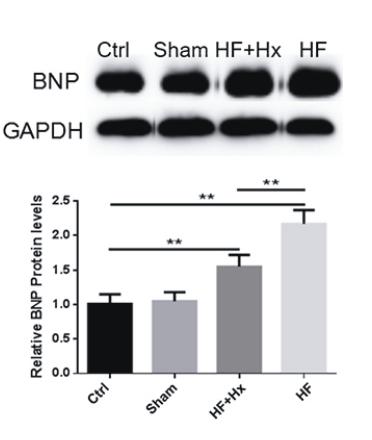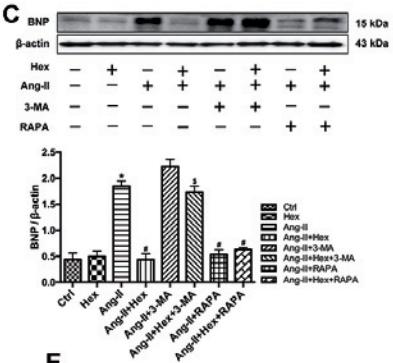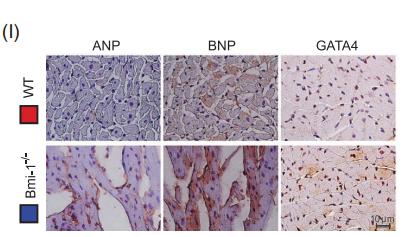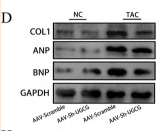NPPB Antibody - #DF6902
| Product: | NPPB Antibody |
| Catalog: | DF6902 |
| Description: | Rabbit polyclonal antibody to NPPB |
| Application: | WB IHC IF/ICC |
| Cited expt.: | WB, IHC |
| Reactivity: | Human, Mouse, Rat |
| Prediction: | Sheep |
| Mol.Wt.: | 15kDa; 15kD(Calculated). |
| Uniprot: | P16860 |
| RRID: | AB_2838861 |
Related Downloads
Protocols
Product Info
*The optimal dilutions should be determined by the end user. For optimal experimental results, antibody reuse is not recommended.
*Tips:
WB: For western blot detection of denatured protein samples. IHC: For immunohistochemical detection of paraffin sections (IHC-p) or frozen sections (IHC-f) of tissue samples. IF/ICC: For immunofluorescence detection of cell samples. ELISA(peptide): For ELISA detection of antigenic peptide.
Cite Format: Affinity Biosciences Cat# DF6902, RRID:AB_2838861.
Fold/Unfold
ANFB_HUMAN; BNP; BNP(1-32); BNP(5-29); BNP-32; Brain type natriuretic peptide; Gamma brain natriuretic peptide; Gamma-brain natriuretic peptide; Natriuretic peptide precursor B; nppb; NT proBNP;
Immunogens
A synthesized peptide derived from human NPPB, corresponding to a region within the internal amino acids.
- P16860 ANFB_HUMAN:
- Protein BLAST With
- NCBI/
- ExPASy/
- Uniprot
MDPQTAPSRALLLLLFLHLAFLGGRSHPLGSPGSASDLETSGLQEQRNHLQGKLSELQVEQTSLEPLQESPRPTGVWKSREVATEGIRGHRKMVLYTLRAPRSPKMVQGSGCFGRKMDRISSSSGLGCKVLRRH
Predictions
Score>80(red) has high confidence and is suggested to be used for WB detection. *The prediction model is mainly based on the alignment of immunogen sequences, the results are for reference only, not as the basis of quality assurance.
High(score>80) Medium(80>score>50) Low(score<50) No confidence
Research Backgrounds
Cardiac hormone which may function as a paracrine antifibrotic factor in the heart. Also plays a key role in cardiovascular homeostasis through natriuresis, diuresis, vasorelaxation, and inhibition of renin and aldosterone secretion. Specifically binds and stimulates the cGMP production of the NPR1 receptor. Binds the clearance receptor NPR3.
The brain natriuretic peptide 32 form is cleaved at Pro-104 by the prolyl endopeptidase FAP (seprase) activity (in vitro).
Secreted.
Brain and also in atria, but at much lower levels than ANP.
Belongs to the natriuretic peptide family.
Research Fields
· Environmental Information Processing > Signal transduction > cGMP-PKG signaling pathway. (View pathway)
References
Application: WB Species: Mouse Sample: hearts
Application: WB Species: mouse Sample: cardiac extracts
Application: IHC Species: mouse Sample: myocardial tissues and cardiomyocytes
Application: WB Species: rat Sample: H9C2 cell
Application: WB Species: rat Sample: cardiac muscle
Restrictive clause
Affinity Biosciences tests all products strictly. Citations are provided as a resource for additional applications that have not been validated by Affinity Biosciences. Please choose the appropriate format for each application and consult Materials and Methods sections for additional details about the use of any product in these publications.
For Research Use Only.
Not for use in diagnostic or therapeutic procedures. Not for resale. Not for distribution without written consent. Affinity Biosciences will not be held responsible for patent infringement or other violations that may occur with the use of our products. Affinity Biosciences, Affinity Biosciences Logo and all other trademarks are the property of Affinity Biosciences LTD.






